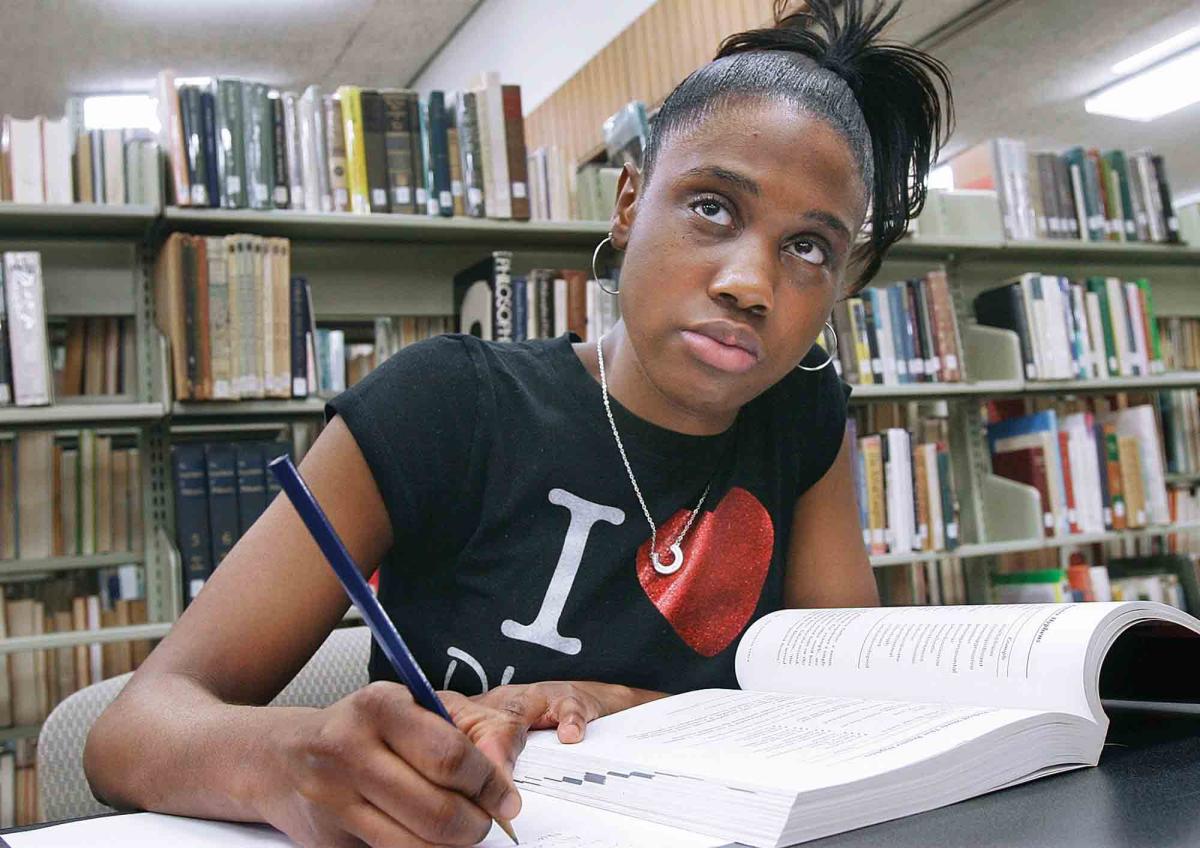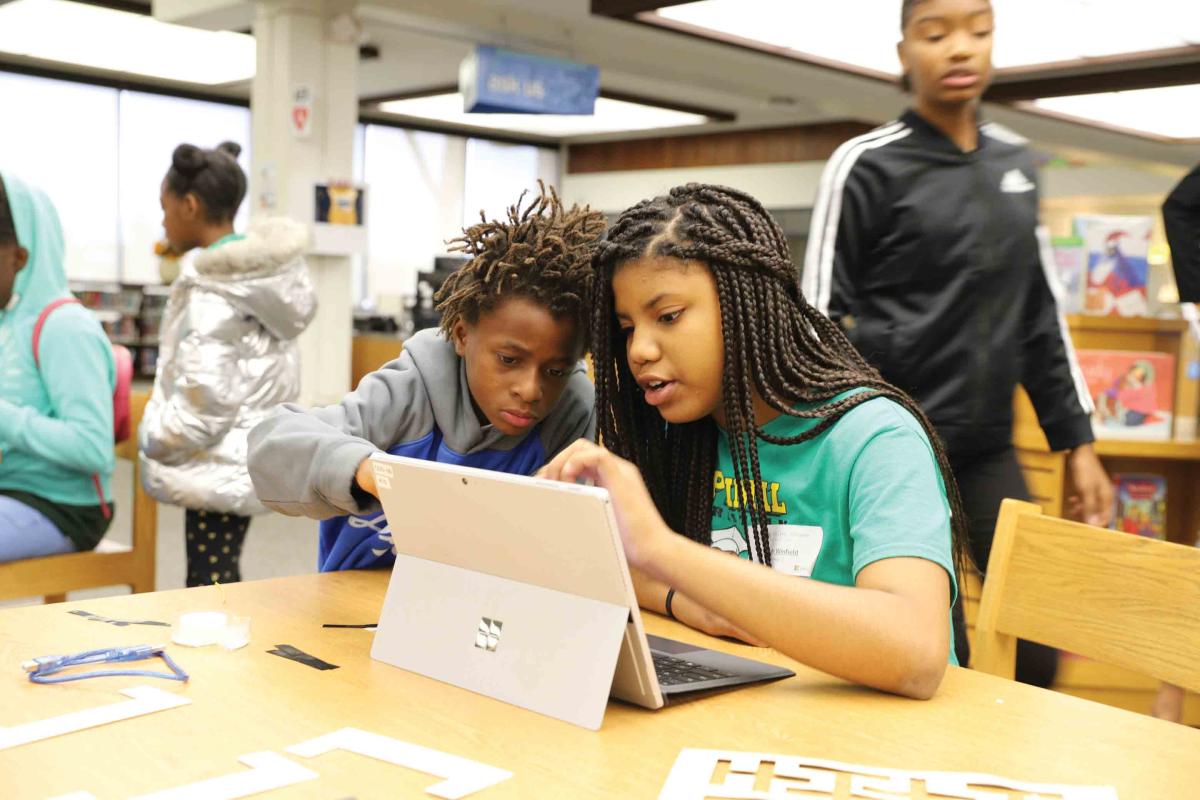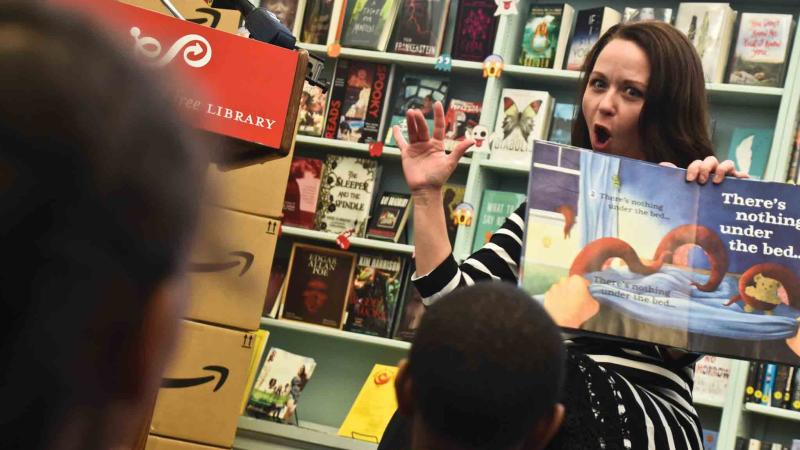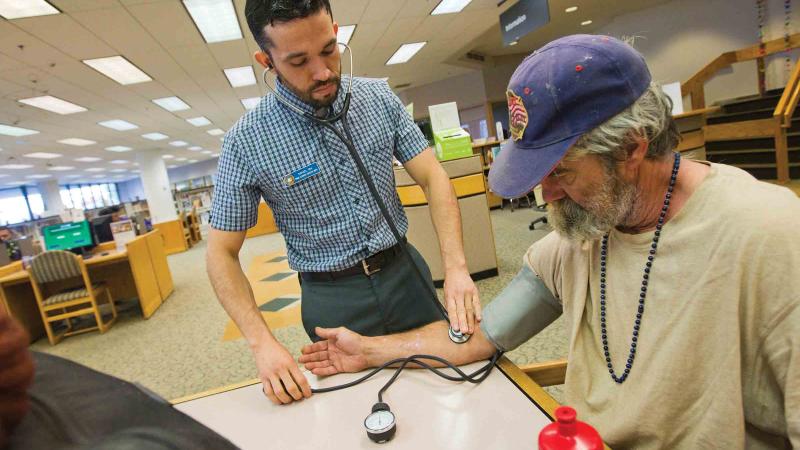The Complicated Role of the Modern Public Library
Something for everyone
“There aren’t many truly public places left in America. Most of our shared spaces require money or a certain social status to access. Malls exist to sell people things. Museums discourage loiterers. Coffee shops expect patrons to purchase a drink or snack if they want to enjoy the premises.”
https://www.neh.gov/article/complicated-role-modern-public-library
The Complicated Role of the Modern Public Library
Something for everyone
The Complicated Role of the Modern Public Library
Something for everyone
“There aren’t many truly public places left in America. Most of our shared spaces require money or a certain social status to access. Malls exist to sell people things. Museums discourage loiterers. Coffee shops expect patrons to purchase a drink or snack if they want to enjoy the premises.
One place, though, remains open to everybody. The public library requires nothing of its visitors: no purchases, no membership fees, no dress code. You can stay all day, and you don’t have to buy anything. You don’t need money or a library card to access a multitude of on-site resources that includes books, e-books and magazines, job-hunting assistance, computer stations, free Wi-Fi, and much more. And the library will never share or sell your personal data.
In a country riven by racial, ethnic, political, and socioeconomic divides, libraries still welcome everyone. “We are open spaces,” says Susan Benton, the president and CEO of the Urban Libraries Council, whose members include public-library systems serving cities large and small across the United States. “We certainly are without judgment about anybody’s characteristics.”
That commitment to inclusivity, along with a persistent ability to adapt to changing times, has kept public libraries vital in an era of divisive politics and disruptive technological change. But it has also put pressure on them to be all things to all people, and to meet a vast range of social needs without correspondingly vast budgets. These days, a branch librarian might run story hour in the morning, assist with a research project at lunchtime, and in the afternoon administer life-saving medical aid to a patron who’s overdosed on the premises.
If the idea of libraries as frontline responders in the opioid crisis sounds far-fetched, look no further than the Denver Public Library. In February 2017, a twenty-five-year-old man suffered a fatal overdose in one of its bathrooms. That prompted the library to lay in a supply of Narcan, a drug used to counteract opioid overdoses. Other libraries, including the San Francisco Public Library, have followed suit and begun to stock the life-saving drug.
Such interventions indicate the expanded role our public libraries now play in a fraying social network. Eric Klinenberg, a sociologist based at New York University, spent a year doing ethnographic research in New York City library branches for his latest book, Palaces for the People: How Social Infrastructure Can Help Fight Inequality, Polarization, and the Decline of Civic Life. Klinenberg borrowed the title from Andrew Carnegie, the Gilded Age industrialist-turned-philanthropist who funded some three thousand public libraries—“palaces for the people”—in the United States and abroad.
In an update of Carnegie’s idea, Klinenberg describes public libraries as “social infrastructure.” That means “the physical spaces and organizations that shape the way people interact,” he wrote in a 2018 op-ed in the New York Times. “Libraries don’t just provide free access to books and other cultural materials, they also offer things like companionship for older adults, de facto childcare for busy parents, language instruction for immigrants and welcoming public spaces for the poor, the homeless and young people.”
Klinenberg’s book is just one of a series of recent high-profile tributes to America’s public libraries. The New Yorker writer Susan Orlean’s most recent book, called simply The Library Book, begins with a personal love song to the subject before diving into the rich, troubled history of the Los Angeles Public Library and its iconic building in downtown L.A. In 2014, the photographer Robert Dawson published a book-length photographic essay that lovingly documents the astonishing variety of the seventeen thousand or so public libraries across the United States, from one-room shacks in the tiniest of towns to branches in strip malls to breathtaking, Carnegie-era book palaces in center cities. And a forthcoming NEH-funded documentary, Free for All: Inside the Public Library, brings to life some of the history and personalities that have shaped this major force for public good.
All of these projects confirm how libraries have proved over and over again, through decades of rapid change and predictions of obsolescence, that they remain essential to Americans’ lives. In an era of extreme weather events and other disasters, they’re becoming even more necessary.
The journalist Deborah Fallows and her husband, James Fallows, road-tripped across the country to report their 2018 book Our Towns: A 100,000-Mile Journey into the Heart of America, in which public libraries play a starring role. “In Ferguson, Missouri, the public library stayed open when the schools were closed after the riots, to offer the kids a safe place and even classes taught by volunteers,” Deborah Fallows wrote in a May 2019 dispatch for the Atlantic. “After the hurricanes in Houston, some library websites were immediately up and running, announcing that they were open for business. After Hurricane Sandy, some libraries in New Jersey became places of refuge. And in the Queens Library’s Far Rockaway branch, which didn’t have heat or light, the librarians set up shop in the parking lot to continue children’s story hours.”
Beyond Books
There are limits to the civic responsibilities public libraries can shoulder. “We’re not the police, we’re not social workers,” says Monique le Conge Ziesenhenne, the director of the Palo Alto City Library system in Silicon Valley and the 2018–19 president of the Public Library Association, a division of the American Library Association. “We do provide an important thread to a community’s well-being and health.”
In calmer times, public library systems offer a staggering array of programming that goes well beyond the books-and-story-time model many of us remember from our childhoods.
Ziesenhenne rattles off a list of some of Palo Alto’s offerings: a seed-lending library, home-brewing tutorials, a “Knack 4 Knitting” club, bilingual story hours, programs designed to help immigrants learn how to live in the United States. Keeping up with a national trend, the library recently created a makerspace with 3-D printers. In July, one branch hosted a workshop on how to use “graywater” from inside a house to sustain native-plant landscaping in the yard.
The list goes on and on. There’s something for almost everyone at the local library, whether you’re a parent who needs literacy support for your preschooler, an immigrant working on language skills or bureaucratic forms, a mystery fan in search of the latest whodunit by a favorite author, or someone experiencing homelessness who needs assistance with social services or access to a computer and the Internet.
Or you could just check out a book, as generations of library patrons have done before you. As extra-literary programs and digital offerings have expanded, the codex has not faded away. “We are still crazy busy with the basic printed materials,” Ziesenhenne says. “In Silicon Valley you would not necessarily expect that, but it’s absolutely true.”
Being located at the wealthy epicenter of the tech revolution doesn’t mean that the library has bottomless funds, though. Like most libraries, “we never have enough money for what we want to do,” Ziesenhenne says.
Even as print thrives, public librarians everywhere spend a lot of time wrangling with the great digital shift and how to adapt to it. In Palo Alto and elsewhere, they’re seeing an increase in the use of digital content as patrons become more familiar with how to use streaming media.
To keep up with changing technology and user expectations, public libraries have invested in more computer terminals and Wi-Fi capability. They have upgraded and expanded facilities to provide more outlets, meeting rooms, study spaces, and seating that patrons can use for extended periods of time as they take advantage of free Wi-Fi.
New, bigger, brighter coworking spaces see high usage among millennials, according to Ziesenhenne. “We are the original sharing economy, I like to say.”
The explosion of information online hasn’t sidelined librarians. It’s only made them more essential at a time when too few of us know how to distinguish real news from the fake variety. “We’ve worked very hard to think about media and how information is presented and ways we can equip people going forward to look for clues on a website,” including asking how old the content is and who’s providing it, Ziesenhenne says.
Librarians have an advantage in making themselves heard through the noise and confusion: Along with nurses and firefighters, they’re among the few groups and institutions Americans still trust, according to Lee Rainie, director of
Internet and technology research at the Pew Research Center.
From 2011 until 2016, Pew did a number of deep-dive studies of public libraries, work funded by the Bill & Melinda Gates Foundation. In those surveys, researchers found that trust in librarians remained high because of their proven ability to curate and share reliable knowledge. “That’s become one of the more precious skills in a world where gaming the information ecosystem is an everyday reality,” Rainie says.
Pew’s library research generated other findings that grabbed media attention: Millennials grew up loving libraries and continue to support and make use of them, Rainie says. Now that they have families of their own, they’ve remained loyal. Having a child under the age of six is the biggest predictor of library use, Rainie adds; parents of young children like the family-friendly programs libraries run.
Pew’s research also found that families often see libraries as sanctuaries. “They were zones of peace, sometimes, in neighborhoods and communities where that was a precious commodity,” notes Rainie.

Formerly homeless high school student, Tinesheia Howard studies at the library of Lincoln College in Lincoln, Illinois.
—AP Photo / Seth Perlman, 2008
For many teens and adults, especially those from underprivileged backgrounds or without computer access at home, the local branch also functions as an on-ramp to the Internet. “Libraries have rebranded themselves as tech hubs without a lot of fanfare,” he says. They allow customers to learn and experiment with new digital resources such as 3-D printers without having to invest in them at home. “People treat libraries as petting zoos for new technology,” as Rainie puts it.
All of those activities require staff time and/or money. As they decide where to spend finite resources, libraries rely on survey data and on detailed conversations with their communities to keep content and programming up to date and adjust what they offer as times and needs change. Library staffers often act as community liaisons even when they’re not on duty, bringing back grassroots knowledge that helps the library add or adapt services in response.
“The library of my youth made all the rules,” says Patrick Losinski, CEO of the Columbus Metropolitan Library in Ohio. The mantra of today’s library, he says, is: How do you meet people where they want to be?
To get answers, the Columbus library recently hired a survey firm to gather information on patrons’ use of and views on the library. The results revealed a virtual town square of activity, with visitors dropping by to check out and return books (41 percent), bring their kids to play area (13 percent), do research (14 percent), read and relax (13 percent), study (9 percent), and use Wi-Fi, computers, printers, or copiers (about 27 percent combined). “Our customers also checked out more than fifteen million items last year, so we’re still a library,” Losinski says.
The survey confirmed that the community views its library as a force for social good. Ninety-one percent of respondents said helping kids by working more closely with schools should be one of the library’s top priorities; 50 percent said that should be its highest priority. Losinski reports that over 50 percent of the area’s youngsters do not have the literacy skill set they need for kindergarten, including basics such as how to hold a book and how to pronounce words they encounter.
Being able to read well gives kids a leg up in schooling and in life, but many children do not have the resources—books at home, parents with time and literacy skills and good child care—to help them master that skill. Public libraries around the country are stepping up to the challenge.
Children participate in 37,000 sessions a year in the Columbus library’s reading-buddies program, which helps kids prepare for a reading-proficiency test in third grade. In Los Angeles County, libraries have recast traditional story time as “school readiness time” and rebranded bookmobiles as “Reading Machines” to visit day care centers and bring parenting-support strategies out into the community.
“Libraries are not about books, they’re about people,” says Skye Patrick, who since 2016 has been the director of the Los Angeles County Library system. When Library Journal named Patrick its Librarian of the Year for 2019, it saluted her “efforts to eliminate barriers and increase access to services for her residents.”

Compton Library holds a Microsoft Digi Camp for students in 2018.
—Los Angeles County Library System
“Equity means different things for different people,” Patrick says. “We wanted to challenge our staff to have a better awareness both of the experience of their colleagues and the experience of their customers.”
Patrick’s strategy to improve library access included putting in place a program called iCount, which provides tools and training for supervisors and staff on how to recognize inherent biases in programs and services. Thinking hard about equity and a wide range of patron experiences and needs is a must for L.A. County’s librarians, who work in one of the four largest and most diverse public library systems in North America. (The other three are the Toronto Public Library, the New York Public Library, and the Los Angeles Public Library system that serves the city of L.A.) The county has 86 library facilities (plus three bookmobiles) that collectively serve about 3.4 million residents; the system covers some 3,000 square miles and 49 cities.
Statistics for the fiscal year that ended June 30, 2018, give a sense of the scale at which it operates: annual circulation—10,857,015; e-book circulation—1,184,289; reference and information questions handled—5,908,474; number of Wi-Fi sessions—4,388,244.
Patrick is no stranger to large library systems; she ran the Broward County Library in Florida before she took her current job. In her experience, there is no workable one-system-fits-all model for public libraries. When she arrived in L.A. County, she set up a listening tour to meet with some of the county’s 3.4 million residents to hear what they wanted from their library.
“I called it a community visioning system, because I wanted the community to actively participate in the creation of the library they needed,” she says. One of the biggest takeaways: “a resounding desire for more hours.” Along with money constraints, “that’s always the issue for every library,” she says.
In response, the system added fifteen thousand more public service hours with some creative strategies that included the use of self-checkout technology, staggered staff schedules, and an additional 1 to 4 service hours per branch per week. “It was low-hanging fruit for us, and it garnered some true goodwill from the community,” Patrick says.
Other requests, such as a kindergarten class’s request to install slides and serve ice cream every day, weren’t feasible—“although we did think about it!” Patrick says. But “based on that response, they associated us with fun, and that’s a big win.” The kids didn’t see the library as stuffy and rule-bound.
Beyond being fun, libraries create sanctuaries for patrons who have few safe spaces in their lives. “There’s a tremendous amount of comfort and safety for people experiencing mental health issues,” Patrick says. “When they’re here, they’re not on the street.”
That inclusivity brings challenges. Some are minor, as when patrons wash up in library bathrooms because they’ve been living on the streets without access to personal-hygiene essentials. But if mental illness is at work, a library user may need a lot more than a place to clean up.
The vast majority of library users do not represent a danger to other patrons or staff, but libraries’ openness carries risks. Librarians have been threatened or killed in the course of doing their jobs. In January 2019, while getting ready for a book sale, the director of the Fort Myers Beach library in Florida was targeted and stabbed to death by a homeless man. A month earlier, in December 2018, the supervisor of the North Natomas branch of the Sacramento Public Library was shot to death in her car in the library’s parking lot by a man she had banned from the library for bad behavior. Her widower wrote an op-ed in American Libraries magazine to call attention to the dangers that library workers face. But security measures like metal detectors or monitoring systems don’t align well with libraries’ commitment to maintaining patron privacy and creating truly open spaces.
Pew’s Lee Rainie describes libraries as “early warning systems for broad cultural phenomena.” Those phenomena can be positive, such as the thirst to experiment with new technology and the desire to broaden access to good information and social services. But they can also be negative. Tensions between different social groups can arise when people who otherwise rarely interact rub elbows at the library.
Skye Patrick identifies a fracture point between what she calls “our two customer bases.” Some patrons ask for more security at library branches or express dismay about disruptions created by homelessness. Her job involves trying to educate one group about the rights of the other. The bottom line for all patrons: “As long as they are adhering to our code of customer expectations, they have the right to use the library,” she says.
The L.A. County bureaucracy, of which the library is a part, can help smooth the way for the disenfranchised. For instance, the Department of Social Services will provide an address for homeless patrons to use in order to get a library card. The library also offers fine-free cards for young people under 21, eliminating one common barrier to full access. (The system hasn’t dispensed with fines altogether yet, although like many libraries it is moving away from fines and has held amnesty periods in which patrons can return overdue materials without penalty.)
Librarians have long helped users navigate life challenges like finding a job, studying for an exam, or applying to school. More and more they play a crucial role in connecting patrons in need of social or mental health services with relevant agencies. “Our branch staff has been trained to at least point to the kinds of services that are available,” Patrick says.
Along with a growing number of libraries, it joined forces with the mental health department to bring social workers on-site to work with patrons in need. Beyond such partnerships with other county agencies, the Los Angeles County Library focuses on fostering what Skye Patrick calls “protective factors”: meaningful social connections, positive parent-child interactions, positive cultural identity, literacy support, and school readiness.
“Time will tell, but I feel really confident that it’s working,” Patrick says, adding that library staff also feel safer with that extra support in place. “That does not mean it solves everything.” Even an institution as resourceful, flexible, and resilient as the public library has its limits.


